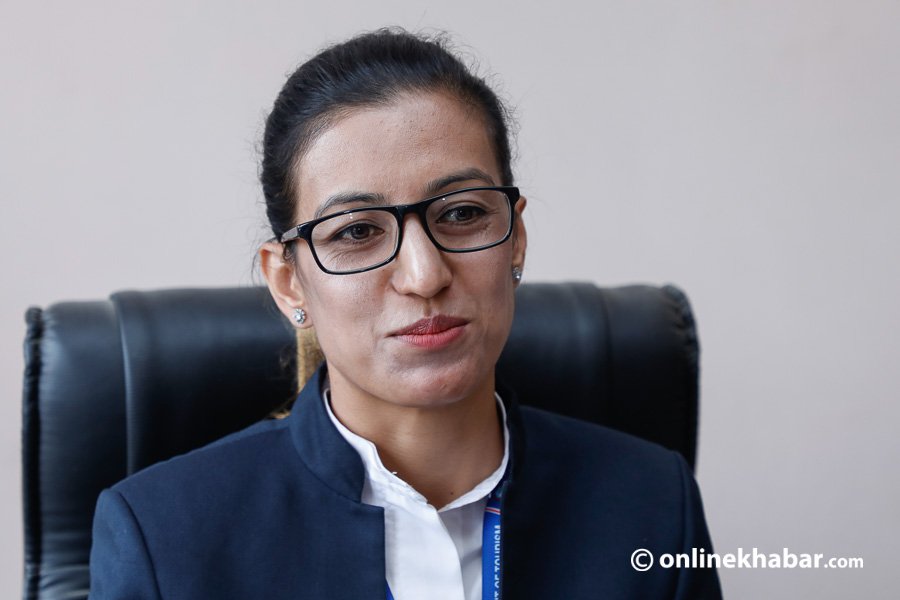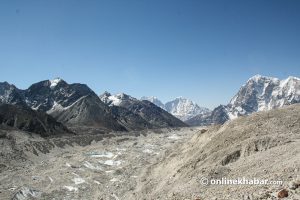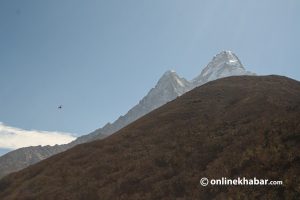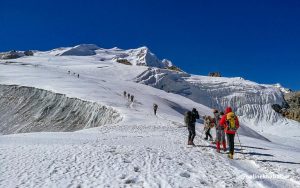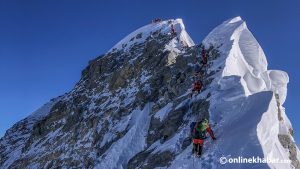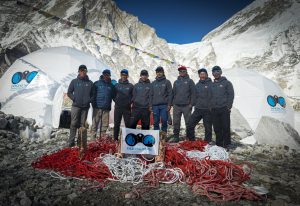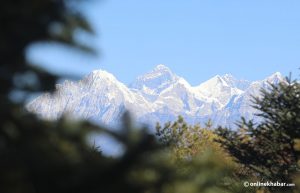Nepal’s Department of Tourism on April 21 released a new directive which has set a climber quota to prevent crowds on Everest. The directive states that mountaineers, selected on the basis of their climbing permit numbers, would be allowed to make attempts at the summit during the first weather window. The decision was made as the numbers of permits for Everest is soon to reach 400.
The directive comes at a time when there are reports of cases of Covid-19 at the Everest Base Camp although the department has dismissed it. Nonetheless, the officials say they are worried about the safety of the climbers and working hard to prevent the further spread of the infection.
The directive, however, has been labelled pointless as a lot of expedition agencies say that it just cannot be implemented on the mountain. However, Mira Acharya, a director at the Department of Tourism, says that the rules are in place to manage the mountain and help reduce crowd. In an interview with Onlinekhabar, she also speaks about an alternative to the quota system and how the department is doing its best with limited resources.
Excerpts:
What is the motive behind this new directive?
It is a plan to stop people from crowding the mountain. Based on past data, we have decided that only a set number of people should be allowed on the mountain. We have given the first right to climbing to the teams that have got their permits first and have acclimatised accordingly. Permits 6 to 38 have the first shot in the first weather window. Every year, there are over 300 climbers on Everest and not all push to the summit at the same time. We are trying out this new rule for the climber’s safety.
But, the new directive has come out a bit late. Why was it the case? Will not it affect the planning?
How can you call it late when ropes are just being fixed and climbers have not even gone up to Camp 1? I feel that this has been taken wrongly. This decision wasn’t made solely by me; it was made after discussion with all parties involved including the Expedition Operator’s Association Nepal (EOA) to ensure a safe mountaineering system.
We want it to be first-come-first-serve because it’s only fair that those who have received their permits first should be the first on the mountain. This is the fair thing to do. Apart from this, we have also given them an alternative.
What alternative?
If this quota system is not applicable, the expedition agencies have the freedom to make decisions based on the conditions. We at the department know, on the mountain, things cannot go as planned, which is why we have said that a total number of 150-170 climbers can go up the mountain in one push. This is based on past data. The expedition companies can coordinate among themselves and determine who goes up the mountain. We have not made the rule rigid. It’s flexible. But, as I said, we want people to be safe.
How will you monitor this? Will it not be hard?
We have liaison officers on the mountain along with other officials. Again, this is not a hard-and-fast rule. We talk to people at the base camp on a regular basis. Apart from that, our law gives permission to the expedition agencies to monitor what happens on the mountain. After all, they are integral to a successful mountaineering season. We have to work together, all of us, the government, the climbers and the expedition agencies if we want a successful season amidst a pandemic.
Is this rule to stop traffic jams on Everest?
I don’t like the word ‘traffic jam’. I don’t believe there are traffic jams in the mountains. The photos you see every year are from a section that is narrow, a bottleneck of sorts, so it is bound to have people regardless of how many are there. We are aware of that and as I have said before, we want to manage the mountain and the season in a better manner. That’s what this rule is for.
The department has handed out nearly 400 permits this year. Could it not limit the number of permits to ensure that people don’t clog up the mountain?
If there was a law to do that, we would have done it a while ago. We have held talks regarding that, but with no law, limiting the number of climbers is going to be tough.
I am sure if we did that, people would be criticising the decision anyway. Expedition agencies would be crying that we took such a decision. For now, we have no plans on limiting the number of climbers.
People in the industry complain that liaison officers don’t make it to the mountain. Cannot the department set up an office at the base camp or at Gorak Shep to monitor things?
Ideally, that would be good. But again, the law does not give us the freedom to do that. Apart from that, the number of people in the department is low. We have less than 30 staff members and this makes it hard. People often criticise the liaison officers, but I feel that it is uncalled for. They and the department are doing our best when it comes to managing and monitoring things on the mountain. But I know, things can be better. We just need favourable laws.
According to permits, it is the Royal Bahrain Guard who will get the first shot on the mountain. People are talking that this rule has been brought for them so that they get the first shot on the mountain. Any comments to those people?
This claim is laughable. We are not biased towards anyone. We don’t do favours. We’re a government body working to protect mountain integrity in Nepal. Had they been the last to take the permit and we had said the last will go first, it would have been so, but it is not the case. The rules are in place for all and have been in place to manage crowds on the mountain and save lives.



